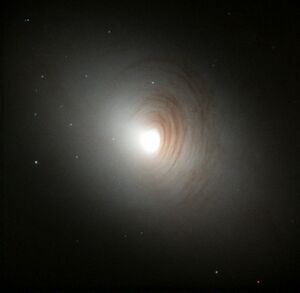Astronomy:NGC 2787
| NGC 2787 | |
|---|---|
 NGC 2787 as observed by the Hubble Space Telescope (HST). | |
| Observation data (J2000 epoch) | |
| Constellation | Ursa Major |
| Right ascension | 09h 19m 18.60430s[1] |
| Declination | +69° 12′ 11.6429″[1] |
| Helio radial velocity | 627.3±13.2 km/s[2] |
| Distance | 24.17 ± 0.46 Mly (7.41 ± 0.14 Mpc)[3] |
| Apparent magnitude (V) | 11.79[4] |
| Apparent magnitude (B) | 12.92[4] |
| Absolute magnitude (B) | −18.84[5] |
| Characteristics | |
| Type | SB(r)0+[6] |
| Mass/Light ratio | 50[5] M☉/L☉ |
| Size | 5.5 kpc[5] |
| Apparent size (V) | 2′.530 × 1′.518[7] (NIR) |
| Notable features | Barred lenticular; LINER |
| Other designations | |
| PGC 26341, UGC 4914[8] | |
NGC 2787 is a barred lenticular galaxy approximately 24[3] million light-years away in the northern constellation of Ursa Major. It was discovered on December 3, 1788 by German-born astronomer William Herschel. J. L. E. Dreyer described it as, "bright, pretty large, a little extended 90°, much brighter middle, mottled but not resolved, very small (faint) star involved to the southeast".[9] The visible galaxy has an angular size of 2.5 × 1.5 arcminutes[7] or 3.24 × 1.81 arcminutes[10] and an apparent visual magnitude of 11.8.[4]
This galaxy is small and isolated[5] with a morphological classification of SB(r)0+,[6] which indicates a barred spiral (SB) with a ring around the bar (r). Being a lenticular galaxy, it has the large halo of an elliptical galaxy. The disk is inclined at an angle of 58°±3° to the line of sight from the Earth, with the major axis aligned along a position angle of 110°±3°.[5] The galaxy has an unusually high mass-to-light ratio, much greater than for a typical spiral galaxy.[5] The distribution of the galaxy's neutral hydrogen forms a clumpy ring with a radius of 10.3 kpc, double that of the visible galaxy, with a mass of 5.5×108 M☉.[5] This ring appears misaligned with the central disk.[11]
NGC 2787 contains a low-ionization nuclear emission-line region (LINER) at its core, which is a type of region that is characterized by its spectral line emission from weakly ionized atoms.[12] LINERs are very common within lenticular galaxies, with approximately one-fifth of nearby lenticular galaxies containing LINERs.[13] The supermassive black hole at the center has a mass of 4.1+0.4
−0.5×107 M☉.[14] The central region of the galaxy contains dust rings that are tilted with respect to the disk, which may be the result of an encounter with another galaxy.[11]
References
- ↑ 1.0 1.1 Brown, A. G. A. (August 2018). "Gaia Data Release 2: Summary of the contents and survey properties". Astronomy & Astrophysics 616: A1. doi:10.1051/0004-6361/201833051. Bibcode: 2018A&A...616A...1G. Gaia DR2 record for this source at VizieR.
- ↑ van den Bosch, Remco C. E. et al. (May 2015). "Hunting for Supermassive Black Holes in Nearby Galaxies With the Hobby-Eberly Telescope". The Astrophysical Journal Supplement Series 218 (1): 13. doi:10.1088/0067-0049/218/1/10. 10. Bibcode: 2015ApJS..218...10V.
- ↑ 3.0 3.1 Tully, R. Brent et al. (October 2013). "Cosmicflows-2: The Data". The Astronomical Journal 146 (4): 25. doi:10.1088/0004-6256/146/4/86. 86. Bibcode: 2013AJ....146...86T.
- ↑ 4.0 4.1 4.2 Véron-Cetty, M.-P.; Véron, P. (2010). "A catalogue of quasars and active nuclei". Astronomy & Astrophysics. 13th 518. doi:10.1051/0004-6361/201014188. A10. Bibcode: 2010A&A...518A..10V.
- ↑ 5.0 5.1 5.2 5.3 5.4 5.5 5.6 Shostak, G. S. (March 1987). "The distribution of HI in the lenticular galaxy NGC 2787". Astronomy and Astrophysics 175: 4–8. Bibcode: 1987A&A...175....4S.
- ↑ 6.0 6.1 Erwin, Peter; Debattista, Victor P. (June 2013). "Peanuts at an angle: detecting and measuring the three-dimensional structure of bars in moderately inclined galaxies". Monthly Notices of the Royal Astronomical Society 431 (4): 3060–3086. doi:10.1093/mnras/stt385. Bibcode: 2013MNRAS.431.3060E.
- ↑ 7.0 7.1 Skrutskie, Michael F.; Cutri, Roc M.; Stiening, Rae; Weinberg, Martin D.; Schneider, Stephen E.; Carpenter, John M.; Beichman, Charles A.; Capps, Richard W. et al. (1 February 2006). "The Two Micron All Sky Survey (2MASS)". The Astronomical Journal 131 (2): 1163–1183. doi:10.1086/498708. ISSN 0004-6256. Bibcode: 2006AJ....131.1163S. https://ui.adsabs.harvard.edu/abs/2006AJ....131.1163S/abstract.
- ↑ "NASA/IPAC Extragalactic Database". Results for NGC 2787. http://nedwww.ipac.caltech.edu/. Retrieved 2006-12-13.
- ↑ Seligman, Courtney. "NGC Objects: NGC 2750 - 2799". Celestial Atlas. https://cseligman.com/text/atlas/ngc27a.htm#2787. Retrieved 2020-09-09.
- ↑ "NGC 2787 - Lenticular Galaxy in Ursa Major". TheSkyLive.com. https://theskylive.com/sky/deepsky/ngc2787-object.
- ↑ 11.0 11.1 Erwin, Peter et al. (November 2003). "When Is a Bulge Not a Bulge? Inner Disks Masquerading as Bulges in NGC 2787 and NGC 3945". The Astrophysical Journal 597 (2): 929–947. doi:10.1086/378189. Bibcode: 2003ApJ...597..929E.
- ↑ Ho, L. C. et al. (1997). "A Search for "Dwarf" Seyfert Nuclei. III. Spectroscopic Parameters and Properties of the Host Galaxies". Astrophysical Journal Supplement 112 (2): 315–390. doi:10.1086/313041. Bibcode: 1997ApJS..112..315H.
- ↑ Ho, L. C. et al. (1997). "A Search for "Dwarf" Seyfert Nuclei. V. Demographics of Nuclear Activity in Nearby Galaxies". Astrophysical Journal 487 (2): 568–578. doi:10.1086/304638. Bibcode: 1997ApJ...487..568H.
- ↑ Graham, Alister W. (November 2008). "Populating the Galaxy Velocity Dispersion - Supermassive Black Hole Mass Diagram: A Catalogue of (Mbh, σ) Values". Publications of the Astronomical Society of Australia 25 (4): 167–175. doi:10.1071/AS08013. Bibcode: 2008PASA...25..167G.
External links
 |

